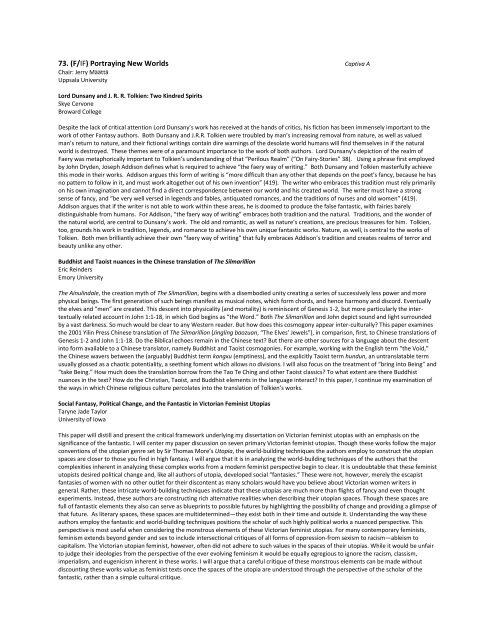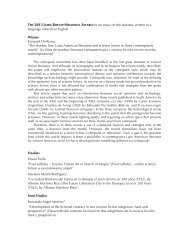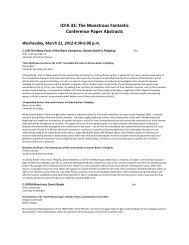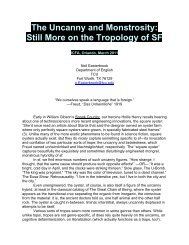On Violence and Becoming: Mala’s Territorial Art of Survival in Shani Mootoo’s Cereus Blooms at NightEmily MutchlerWestern Illinois UniversityElizabeth Grosz’s Chaos, Territory, Art, and Donna Haraway’s When Species Meet both critically engage the human/animal dichotomy whichdrives so much of the anglocentrism of imperial thought. Drawing on these texts, I will demonstrate the ways in which Mala’s “becominganimal” in Shani Mootoo's Cereus Blooms at Night constitutes what Frantz Fanon describes as the first act of the anti-colonial revolution, ratherthan simply a young woman’s tortured retreat from sexual and colonial violence into “madness.” Unfortunately, Mala’s psychic pain does notend with the death of her abusive father and, similarly, Fanon points out that the struggle of decolonization does not end once the colonizersleave. In much the same way that in writing Cereus Blooms at Night, Mootoo acknowledges the epistemological language of the colonizer, butundermines it by having the creatures of Mala’s garden roam freely; Mala has to carve out her own territory among the remains of Wetlandishstatues, mausoleum, and the Thoroughly’s mission; she has to try to reappropriate the tools of the colonizer to build a safe home for herself.Finally, drawing from “<strong>The</strong> Paradise Alms House” and When Species Meet, I will discuss the ways in which former subjects can truly decolonizethemselves and each other within the safe space of the Alms House. Here, the residents and staff are at first bewildered, but then inspired byMala and Tyler’s mutual becoming. <strong>The</strong>n the people of the Alms House can redefine notions of “family” and “home” to welcome queerness, ordifference- to reclaim their long-lost brothers, sisters, and pieces of themselves.Reflections in a Jagged Mirror: How Women’s Postcolonial Vampire Writing Problematizes the <strong>Monstrous</strong> “Other”: Nalo Hopkinson’s“Greedy Choke Puppy” and Tananarive Due’s “My Soul to Keep”Gina WiskerUniversity of Brighton<strong>The</strong> figure of the postcolonial vampire in writing by women from the US and the Caribbean engages the monstrous, the vampire, with issues ofhistory, power, gender, identity and self worth. It represents and enacts the discomfort of an everyday reminder of the hidden denials anddestruction of the colonial and imperial past and the liminal spaces limed with that past in which we now all walk and live. Where thepostcolonial Gothic and the monstrous figure of the vampire, boundary crosser, transgressive, invasive Other, are inflected by gender, it dealswith more than a troubled violent repressed past and engages with the debilitating effects of internalising a monstrous, negative view of self, alack of self worth. <strong>The</strong> un-dead stalking the living to feed on them; the liminal space between living and dead, history and the present, thedraining effect of a damaging and undying history on those who carry it about with them on an everyday basis. <strong>The</strong>se characteristics of thepostcolonial condition are also descriptions of the vampire, such a versatile figure with which to uncover and explore fears of identity,belonging, ownership and the stability of self and others. Tabish Khair in Ghosts from the Colonies (2010) highlights the ways in which thepostcolonial Gothic uses strategies of Othering, and Julia Kristeva (Powers of Horror 1984 ) emphasises the ways in which that which is Other isdefined as abject, to be rejected with disgust (often mixed with desire)but finally to be recognised as our own production, a version of theprojected monster self. <strong>The</strong> un-dead vampire offers an opportunity for longing, loss and melancholy, and endless draining, mourning of thehurtful damaging, undeniable colonial and imperial past which, once revealed, cannot ever be fully laid to rest. It also exposes weaknesses, andthreats. <strong>The</strong> melancholy in action and aggressive angry vengeance are each features of both the postcolonial condition and of the postcolonialvampire’s recurrent, morphing presence in our myths and literature. In women’s writing this vampire often also engages with the self loathinggrown from internalising a racialised, negative self image. Such self loathing combines with fears of loss of beauty, ageing, and with thecosmetic narrative of the need to retain youth and the power of beauty. Women postcolonial vampire writers look at ways in which womenself construct as monstrous, at the debilitating narratives which undermine self image and self worth, relationships of power anddisempowerment, at beauty, self worth, sisterhood, families and communities. Nalo Hopkinson’s ‘Greedy choke puppy’ uses the figure of thesoucouyant to expose and indict an internalised fear of ageing which leads to the destruction of others. Tananarive Due’s My Soul to Keep and<strong>The</strong> Living Blood creates a vampire community in Africa which replicates the divisive destructiveness of racism in their treatment of mortalsand women as lesser beings on whom to merely prey, and who need to learn to treat difference as equal. Narrative trajectories in work bywomen vampire writers combine a rejection of the historically inherited negatives and silencing, with moving towards a celebration ofsisterhood and community. Postcolonial women’s vampire narratives problematise the traditional trajectory established in Dracula whereforeignness is terrifyingly invasive, to be rejected and destroyed, and women’s sexuality is seen as monstrous, demonic. Facing the vampirewho is also ourselves (Auerbach, 1995 ) means recognising that we construct this monster figure from our own desires and fears. It can, likethe Gothic itself, expose hypocrisies and contradictions, hidden secrets and vulnerabilities and also it has a social intent. It is the facility of theliterary vampire to be re-imagined in different contexts that has also made it a favourite among post colonial Gothic writers who seek toexplore the melancholic mourning and loss, the invasive violent disturbance of that which is hidden and denied, and the opportunities that thisfigure offers for social and cultural critique. In the hands of some contemporary post colonial women writers of the Gothic and horror it alsooffers an opportunity to rewrite history and to suggest alternative ways of being. As Wilson Harris comments, the prisonhouse of history canbe deconstructed and rebuilt in a liberating form. <strong>The</strong> metamorphosing boundary crossing postcolonial vampire is a key figure in this reempoweringchange <strong>The</strong> liberating powers of the imagination record different histories and presents, envision alternative futures.Contemporary postcolonial African American and Afro Caribbean women writers use elements of horror springing from the literary Gothic,from myth, the supernatural, the fantastic, to critique the legacy of slavery and racism, and current issues such as power and identity inflectedby gender, race & history. <strong>The</strong> work of Nalo Hopkinson and Tananarive Due uses ghosts, vampires, werewolves, voodoo and various horrorfigures as vehicles through which to remind, indict, review and revise. In their work, the postcolonial vampire provides a radical challenge togendered and racialised constructions of the abject, and recuperates the Monster other.
73. (F/IF) Portraying New Worlds Captiva AChair: Jerry MäättäUppsala UniversityLord Dunsany and J. R. R. Tolkien: Two Kindred SpiritsSkye CervoneBroward CollegeDespite the lack of critical attention Lord Dunsany’s work has received at the hands of critics, his fiction has been immensely important to thework of other Fantasy authors. Both Dunsany and J.R.R. Tolkien were troubled by man’s increasing removal from nature, as well as valuedman’s return to nature, and their fictional writings contain dire warnings of the desolate world humans will find themselves in if the naturalworld is destroyed. <strong>The</strong>se themes were of a paramount importance to the work of both authors. Lord Dunsany’s depiction of the realm ofFaery was metaphorically important to Tolkien’s understanding of that “Perilous Realm” (“On Fairy-Stories” 38). Using a phrase first employedby John Dryden, Joseph Addison defines what is required to achieve “the faery way of writing.” Both Dunsany and Tolkien masterfully achievethis mode in their works. Addison argues this form of writing is “more difficult than any other that depends on the poet's fancy, because he hasno pattern to follow in it, and must work altogether out of his own invention” (419). <strong>The</strong> writer who embraces this tradition must rely primarilyon his own imagination and cannot find a direct correspondence between our world and his created world. <strong>The</strong> writer must have a strongsense of fancy, and “be very well versed in legends and fables, antiquated romances, and the traditions of nurses and old women” (419).Addison argues that if the writer is not able to work within these areas, he is doomed to produce the false fantastic, with fairies barelydistinguishable from humans. For Addison, “the faery way of writing” embraces both tradition and the natural. Traditions, and the wonder ofthe natural world, are central to Dunsany’s work. <strong>The</strong> old and romantic, as well as nature’s creations, are precious treasures for him. Tolkien,too, grounds his work in tradition, legends, and romance to achieve his own unique fantastic works. Nature, as well, is central to the works ofTolkien. Both men brilliantly achieve their own “faery way of writing” that fully embraces Addison’s tradition and creates realms of terror andbeauty unlike any other.Buddhist and Taoist nuances in the Chinese translation of <strong>The</strong> SilmarillionEric ReindersEmory University<strong>The</strong> Ainulindale, the creation myth of <strong>The</strong> Silmarillion, begins with a disembodied unity creating a series of successively less power and morephysical beings. <strong>The</strong> first generation of such beings manifest as musical notes, which form chords, and hence harmony and discord. Eventuallythe elves and “men” are created. This descent into physicality (and mortality) is reminiscent of Genesis 1-2, but more particularly the intertextuallyrelated account in John 1:1-18, in which God begins as “the Word.” Both <strong>The</strong> Silmarillion and John depict sound and light surroundedby a vast darkness. So much would be clear to any Western reader. But how does this cosmogony appear inter-culturally? This paper examinesthe 2001 Yilin Press Chinese translation of <strong>The</strong> Silmarillion (Jingling baozuan, “<strong>The</strong> Elves’ Jewels”), in comparison, first, to Chinese translations ofGenesis 1-2 and John 1:1-18. Do the Biblical echoes remain in the Chinese text? But there are other sources for a language about the descentinto form available to a Chinese translator, namely Buddhist and Taoist cosmogonies. For example, working with the English term “the Void,”the Chinese wavers between the (arguably) Buddhist term kongxu (emptiness), and the explicitly Taoist term hundun, an untranslatable termusually glossed as a chaotic potentiality, a seething foment which allows no divisions. I will also focus on the treatment of “bring into Being” and“take Being.” How much does the translation borrow from the Tao Te Ching and other Taoist classics? To what extent are there Buddhistnuances in the text? How do the Christian, Taoist, and Buddhist elements in the language interact? In this paper, I continue my examination ofthe ways in which Chinese religious culture percolates into the translation of Tolkien’s works.Social Fantasy, Political Change, and the <strong>Fantastic</strong> in Victorian Feminist UtopiasTaryne Jade TaylorUniversity of IowaThis paper will distill and present the critical framework underlying my dissertation on Victorian feminist utopias with an emphasis on thesignificance of the fantastic. I will center my paper discussion on seven primary Victorian feminist utopias. Though these works follow the majorconventions of the utopian genre set by Sir Thomas More’s Utopia, the world-building techniques the authors employ to construct the utopianspaces are closer to those you find in high fantasy. I will argue that it is in analyzing the world-building techniques of the authors that thecomplexities inherent in analyzing these complex works from a modern feminist perspective begin to clear. It is undoubtable that these feministutopists desired political change and, like all authors of utopia, developed social “fantasies.” <strong>The</strong>se were not, however, merely the escapistfantasies of women with no other outlet for their discontent as many scholars would have you believe about Victorian women writers ingeneral. Rather, these intricate world-building techniques indicate that these utopias are much more than flights of fancy and even thoughtexperiments. Instead, these authors are constructing rich alternative realities when describing their utopian spaces. Though these spaces arefull of fantastic elements they also can serve as blueprints to possible futures by highlighting the possibility of change and providing a glimpse ofthat future. As literary spaces, these spaces are multidetermined—they exist both in their time and outside it. Understanding the way theseauthors employ the fantastic and world-building techniques positions the scholar of such highly political works a nuanced perspective. Thisperspective is most useful when considering the monstrous elements of these Victorian feminist utopias. For many contemporary feminists,feminism extends beyond gender and sex to include intersectional critiques of all forms of oppression-from sexism to racism—ableism tocapitalism. <strong>The</strong> Victorian utopian feminist, however, often did not adhere to such values in the spaces of their utopias. While it would be unfairto judge their ideologies from the perspective of the ever evolving feminism it would be equally egregious to ignore the racism, classism,imperialism, and eugenicism inherent in these works. I will argue that a careful critique of these monstrous elements can be made withoutdiscounting these works value as feminist texts once the spaces of the utopia are understood through the perspective of the scholar of thefantastic, rather than a simple cultural critique.
- Page 4 and 5: 5. (F) Wondrous Bodies of the Gende
- Page 6 and 7: Fantastic Suicide: Reading the Unca
- Page 8: Viral Posthumanism: Boundaries and
- Page 11 and 12: The Concept of Soul Divisibility in
- Page 13 and 14: Thursday, March 22, 2012 10:30 a.m.
- Page 15 and 16: 21. (CYA) Terrifying Futures: Post-
- Page 17 and 18: 23. (FTV/H) Now I’m Feelin’ Zom
- Page 19 and 20: Fight Club: Amalgam of the Horrific
- Page 21 and 22: Taking the Monsters out of the Clos
- Page 23 and 24: Kaspar J. SaxenaIndependent Scholar
- Page 25 and 26: 44. (CYA) The Monstrosity of Teenag
- Page 27 and 28: 46. (FTV/SF) Monstrous Spin-offs: T
- Page 29 and 30: 49. (F) Aspects of Miéville Captiv
- Page 31 and 32: 53. (SF) War and Crisis in 1940s an
- Page 33 and 34: Abuse of Power: An Evolutionary Res
- Page 35 and 36: Disappearing Natives: The Colonized
- Page 37 and 38: 60. (H/IF) Ancient and Medieval Mon
- Page 39 and 40: 62. (F) The Works of Tolkien Captiv
- Page 41 and 42: 67. (SF) Imperial and Postcolonial
- Page 43 and 44: Beheading the Gorgon: Beautifying C
- Page 45: 71. (VPA) Monstrous Music MagnoliaC
- Page 49 and 50: Friday, March 23, 2012 2:45-3:45 pm
- Page 51 and 52: 81. (FTV) Those Damn Dirty Apes! Cy
- Page 53 and 54: Friday, March 23, 2012 4:00-5:30 pm
- Page 55 and 56: 92. (F) Leaving the Demonized Other
- Page 57 and 58: 94. (FTV/CYA) Monstrosity and Devia
- Page 59 and 60: of cannibalism, ghostly seduction i
- Page 61 and 62: Saturday March 24, 2012 8:30-10:00
- Page 63 and 64: 104. (CYA) Classic Monsters, Reinte
- Page 65 and 66: 107. (VPA) Monstrous Gaming Bodies
- Page 67 and 68: who challenge the order that the Br
- Page 69 and 70: Reading Between the Times: A Critic
- Page 71 and 72: 117. (FTV) Monsters and Superheroes
- Page 73 and 74: 119. (IF/H/PCS) International Mash-
- Page 75 and 76: Focusing on Stoker's Dracula as one
- Page 77 and 78: Florida Atlantic UniversitySheri S.
- Page 79 and 80: Simmons CollegeIn the spate of rece
- Page 81 and 82: Independent ScholarKing’s story
- Page 83 and 84: modernity opens up for every indivi
- Page 85 and 86: Saturday March 24, 2012 4:00-5:30 p
- Page 87 and 88: 141. (FTV) Monstrous Masculinity Cy
- Page 89 and 90: ultimately make peace with her mons
- Page 91 and 92: where the almost-human sentient zom





